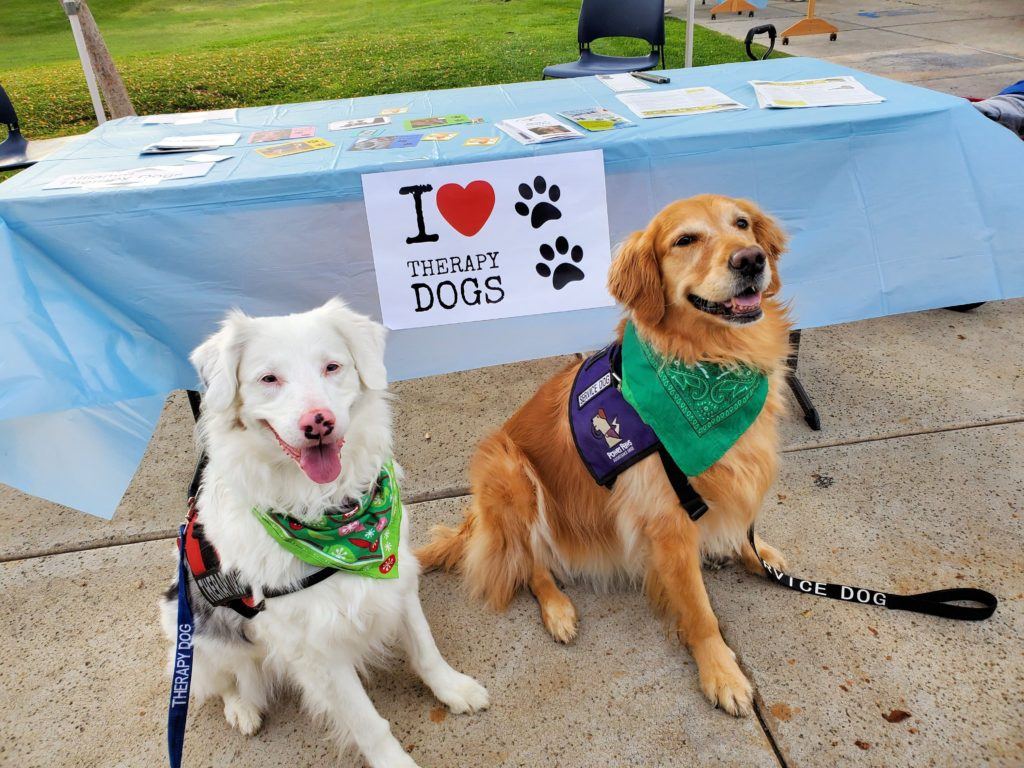
Ivy Blog
Extending A Helping Paw: How Animal-Assisted Therapy Benefits Brain Tumor Patients
- March 2, 2022
- Ivy Center
- Posted in Patient Support

Pets are beloved members of the family, with over 90.5 million households in America owning at least one. Many people affectionately refer to pets as their “fur babies.” The comfort and unconditional love animals provide can be extremely soothing and healing, which is why animal-assisted therapy, particularly with dogs, is so popular for helping people cope with a variety of health conditions.
Therapy dogs visit hospitals, assisted living facilities, memory care homes, schools, airports, national disaster areas and more. “There are many benefits people receive from therapy dogs, such as lowered anxiety, increased physical activity, improved mental functioning and reduced loneliness to highlight a few,” says Julie Brewer, founder of K9 therapy and service dog trainer. “In my experience, the mere presence of a therapy dog can have a positive effect on someone who is experiencing pain or in crisis.” Another perk of working with dogs is that they don’t judge us and they expect nothing in return for their affection.

The Healing Power Of Pet Therapy
Dogs are extremely intuitive. They can sense when people are in distress or not feeling their best. Brain tumor survivor and Better Together host Maria Menounos took to Instagram to share how her dogs provided comfort to both her and her mom when they were sick, “Animals really are a gift from God. Whenever I’m feeling down they just know and come by my side to comfort me. When I was recovering from brain surgery, Whinnie sat on my lap day and night. Same with my mom when she was sick.”
Emotional Distress
For people who are under extreme emotional distress caused by a traumatic experience, such as being on the receiving end of a difficult diagnosis, a therapy dog can provide instant comfort in that moment and beyond. Even the repetitive behavior of petting a dog is soothing. “It’s been many years, but I recall the comfort I felt from a dog when I was first diagnosed with a brain tumor, ” says Lanette Veres, founder of The Gray Matters Foundation. “Years later, our family got a cat we named Angel after my grandmother passed away and she provided tremendous comfort to all of us during that difficult time.”
Mood Boosting

Many pet therapy teams are there to brighten someone’s day. Dogs have a mood-boosting effect that is scientifically proven to increase oxytocin levels, known as the love hormone, and decrease cortisol levels, which is commonly associated with stress. While one session with a therapy dog won’t have a long-term effect on a condition such as depression, it does have an immediate benefit in the moment. With routine visits, people may find themselves feeling happier as they move about their day. Sharon Martin is the handler of Abby, a ten-year old therapy dog that visits brain tumor patients at Barrow Neurological Institute. She says that when patients are having a terrible day or have been unresponsive, she comes in with Abby and their whole demeanor changes. It’s also a welcome distraction for their loved ones.
Motivation
It turns out the expression you can’t ignore the elephant in the room also applies to dogs. During a rehabilitation session, if a dog is in the room, the additional support can help motivate a patient to push themselves even further. Therapists may have a dog walk alongside the patient at each marker, and as the patient advances, the therapist increases their responsibility by having them hold the dog’s leash. The therapist and dog work together to support and motivate the patient to keep going.
Companionship
The pandemic has had an isolating effect on many people, especially brain tumor patients, who have to spend extended periods of time in the hospital and have weakened immune systems due to treatment. A routine visit from a therapy dog can provide patients who are experiencing loneliness, or who are unable to see their loved ones, with a sense of companionship during a difficult and often scary time.
Social interactions
In group settings, therapy dogs are effective in motivating people to open up and feel more comfortable sharing how they are feeling. “When I facilitate the support groups for brain tumor patients and their families, I make it a point to discuss our animals at home and how they lift us up,” says Lanette Veres. “It’s a great way to break the ice and encourage people to talk about something special to them.”
Learning
For people who have suffered a loss of function, such as the ability to speak or read, due to a brain tumor, incorporating a therapy dog into learning sessions will help them feel more at ease while they practice reading aloud or uniciating words. Therapy dogs also infuse an element of fun and enjoyment for patients going through speech or occupational rehabilitation. Take the story of Abby, who learned a trick to help patients working on speech. Each time the patient was prompted to ask a basic question requiring a yes or no answer indicated on a card, Abby would point to the correct answer on the card by nodding her head.
Finding An Animal-Assisted Therapy Service

Therapy dogs are a great addition to one’s treatment team, and with frequent visits from a therapy dog, patients can make big strides both physically and emotionally.
If you’re interested in animal-assisted dog therapy, check with your physician or local support group. You can also find more information by visiting the Alliance of Therapy Dogs and Pet Partners.
Has a furry friend helped you or a loved one through a difficult diagnosis or illness, such as a brain tumor? We would love to see photos of you and your “fur baby.” Post your photos on social media and tag us @theivybraintumorcenter so we don’t miss them!
